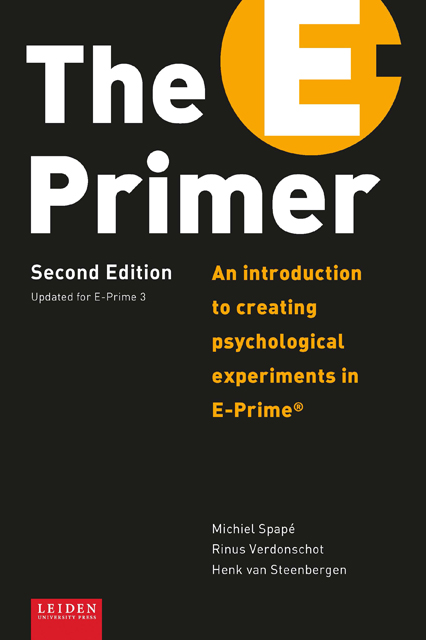Book contents
- Frontmatter
- Table of Contents
- Preface to the Second Edition
- Preface to the First Edition
- Introduction
- Chapter I E-Prime at a glance
- Chapter II List Attributes and Slides
- Chapter III Sound, movies, hardware, and nested Lists
- Chapter IV Beginning programming in E-Prime
- Chapter V Decision making in E-Basic
- Chapter VI Loops and Arrays in E-Basic
- Chapter VII Interactions between Slide objects and the Mouse
- Chapter VIII Various Input/Output devices
- References
- Appendix: Overview of available E-Objects
- About the authors
- Index
Chapter V - Decision making in E-Basic
Published online by Cambridge University Press: 22 November 2022
- Frontmatter
- Table of Contents
- Preface to the Second Edition
- Preface to the First Edition
- Introduction
- Chapter I E-Prime at a glance
- Chapter II List Attributes and Slides
- Chapter III Sound, movies, hardware, and nested Lists
- Chapter IV Beginning programming in E-Prime
- Chapter V Decision making in E-Basic
- Chapter VI Loops and Arrays in E-Basic
- Chapter VII Interactions between Slide objects and the Mouse
- Chapter VIII Various Input/Output devices
- References
- Appendix: Overview of available E-Objects
- About the authors
- Index
Summary
In this chapter, you will learn
In this chapter you will meet some more advanced E-Prime magic. You will learn how to implement two very interesting psychological paradigms, namely the Ultimatum and Cyberball games. As these games require decision making, you need to know how to implement decision making code within an experimental design. Therefore, we first explain certain decision structures with the use of flow charts, which is a helpful way of visualising a program's decision structure before getting down to actually implementing it. Then you will learn some E-Basic commands, such as If-Then, and several important operators (And, Not and the beloved Xor). In addition, you find out how to end the experiment (or part of it) prematurely, based on certain conditions. Finally, in two tutorials, you will learn how to put this knowledge to use and create the Ultimatum and Cyberball games for yourself.
The If-Then statement
Like shopping, programming is all about making the right decisions. The way this works in programming context is that we ask the computer to run one piece of code, or another, depending on the value of some variable. That is, depending on the value of the variable, the program proceeds down one path, or the other. This is called a branching structure.
For example, assume that you have set up an experiment where timing is critical. You want it to only run with a screen refresh rate of 60 Hz. In a flow chart, we can map out exactly how this will work.
From this flow chart, we can see that the program has to makes a decision: depending on the conditional expression ‘ screenfreq = 60’ the experiment should proceed with (run) one of the two branches. The decision part of this chart (the diamond symbol) demonstrates that we need a so-called control structure.
To implement this structure in E-Basic, we need the If-Then-Else-EndIf statement (for short, the If-Then statement). This statement (or combination of statements) checks a set of conditions, and if the conditional expression is evaluated to True, then the program takes some particular course of action. Optionally, if the condition is not met, it does something else instead.
- Type
- Chapter
- Information
- The E-PrimerAn Introduction to Creating Psychological Experiments in E-Prime, pp. 135 - 160Publisher: Amsterdam University PressPrint publication year: 2019



